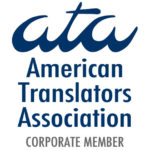Translation events – July 2015
The Internationalization Readiness Checklist. Globalization and Localization Association. Webinar
7-10
5th IATIS Conference. International Association for Translation and Intercultural Studies. Belo Horizonte, Brazil
13-17
International Network for Terminology (TermNet). International Terminology Summer School 2015. Cologne, Germany
15-19
The Local App: Language and Culture in a Flat World
Middlebury Language Schools. Middlebury, Vermont / MIlls College, California, USA
16
Alolita Sharma on internationalization and localization at Twitter
The International Multilingual User Group (IMUG), California, USA
16-18
Supreme Courts of Arkansas & Louisiana Admin Office of Courts’ Court Interpreter Programs of Mississippi & Tennessee 2015 Legal Interpreting Seminar. Little Rock, A. USA
20-24
13th International Linguistics Olympiad. IOL. Blagoevgrad, Bulgaria
Starting a career in translation
 In a world whose globalized market means that the positive or negative evolution of one nation’s economy can have effects – sometimes devastating – across the planet, there is one industry that has continued to grow both in complexity and extension due to a seemingly never-ending demand for information sharing: the translation industry. Recent studies from Common Sense Advisory reveal that the translation industry is estimated to be worth over $33.5 billion globally, with predictions by some that it could reach $39 billion by 2018. In the US, this means some additional 12,400 jobs – a 36% increase – by 2019. The U.S. Bureau of Labor Statistics also predicts a whopping 46% percent growth between 2012 and 2022, far greater than the average 11% growth for all careers.
In a world whose globalized market means that the positive or negative evolution of one nation’s economy can have effects – sometimes devastating – across the planet, there is one industry that has continued to grow both in complexity and extension due to a seemingly never-ending demand for information sharing: the translation industry. Recent studies from Common Sense Advisory reveal that the translation industry is estimated to be worth over $33.5 billion globally, with predictions by some that it could reach $39 billion by 2018. In the US, this means some additional 12,400 jobs – a 36% increase – by 2019. The U.S. Bureau of Labor Statistics also predicts a whopping 46% percent growth between 2012 and 2022, far greater than the average 11% growth for all careers.
Two factors are driving this exponential growth, and both seem to be long-term trends: businesses expanding to new markets abroad, and increased immigration
With this increasing demand for translators, it’s logical to ask how exactly does one become a translator.
Most translators arrive at their profession via two main paths: education or practical experience.
More and more universities are offering degrees or professional certificates in translation (or translation and interpreting), and there are also, of course, the traditional on-campus programs as well.
Another option, and one that is actually quite common, is to use the experience gained from working as a professional in another field – law, architecture and medicine are common – and apply it to translation work.
Speaking a second language, though, is not enough: Regardless of the path chosen, there are requirements that any translator must meet, and these include native-level language ability in the language you wish to translate into (professional translators generally translate into their native language only); an outstanding knowledge of the foreign language you are translating from, including cultural nuances; excellent writing skills (you must be able not only to understand the source text, but also replicate its style and register); analytical skills (to understand what you read); research skills (for terminology); and IT skills (technology plays an increasingly important role in today’s translation industry, and is key to an efficient business operation).
And there’s another personality trait that can make you a top-level translator: curiosity. Curiosity drives the translator to learn new skills, look up unfamiliar words, research unfamiliar subjects and, in general, to nose around the topic of the translation at hand until he not only understands the words in the translation, but the concept as well.
Most translators work as freelancers; in the US, earnings average about $45,000 a year. However, depending on the language combination (translating from French into Chinese, for example, commands a higher rate than translating from Spanish into English) and the industry (a local community center or a Fortune-500 company), salaries can run into six figures.
One downside to the industry is the fact that there are few official standards that place limits on who can call themselves a translator, and few official bodies that certify translators (the main body in the US is the American Translators Association). As a result, the industry has been flooded with amateurs who attempt to compete with professionals, which makes degrees and certifications invaluable tools when offering translation services.
The exponential growth of the translation industry has opened the door to language lovers who have the skills and knowledge – and are willing to expend the time and effort to develop them to their fullest potential – to create communication bridges worldwide, and translation professionals are always glad to welcome fellow professional translators into the world of multilingual communication.
Translation events – June 2015
ABRATES VI. Brazilian Association of Translators (ABRATES),
Sao Paulo, Brazil
4-5
2nd International Postgraduate Conference in Translation and Interpreting Studies at Queen’s University Belfast, Belfast, Northern Ireland
7-10
5th IATIS Conference. Belo Horizonte, Brazil
12-13
InterpretAmerica, 5th Anniversary InterpretAmerica Summit
Ride the Way: Finding Opportunity in Uncharted Waters
Monterey, CA, USA.
13
Northern California Translators Association (NCTA), Workshop: Getting Started as an Interpreter, San Francisco, CA, USA.
13-14
ProZ.com 2015 international conference Rotterdam, the Netherlands
18
Bridge for Out of Eden Walk: 21,000 Miles of Social Media in Translation. The International Multilingual User Group (IMUG).
Menlo Park, California, USA
Overcoming the Challenges of Agile Localization Globalization and Localization Association, webinar
18-19
Localization unconference, Munich, Germany
18-20
TAO-CAT-2015. Université Catholique de l’Ouest, Société française des traducteurs. Angers, France
19-20
Simposio Hispanoamericano de Traducción Especializada y Nuevas Tecnologías, Buenos Aires, Argentina.
20-21
IJET-26. Japan Association of Translators. York, UK
26-28
Translation Forum Russia. Business Bureau of the Association of Interpreters. Moscow, Russia
27-28
NZSTI 2015. New Zealand Society of Translators and Interpreters. Wellington, New Zealand
29-Jul 1
Game QA & Localization Europe,IQPC, Barcelona, Spain
Prioritizing your Translation Needs: Quality, Speed and Price
When you have a large – or even small – translation project at hand, there are three factors that you should take into consideration when choosing a translation agency, and they come from the classic quality/speed/cost project management triangle.
In an ideal business world, your goal would naturally be to achieve all three goals, and end up with a top-quality translation, delivered quickly at the lowest possible price. However, in the real world, achieving all three goals equally can pose significant challenges. Let’s see why.
One flaw in this paradigm is the assumption that these factors are of equal importance, but this is a fallacy. In the business world, poor quality is never an option for a company who wishes to keep its clients and grow its business. In this globalized business environment, your company’s written materials – especially its website – are its calling card. And how very important that card is: a 2011 study carried out by Briton Charles Duncombe, who manages online shops in various industries, found that spelling and grammar mistakes undermine the credibility of the company and the trust of the consumer, often in the first 10 seconds the web page is viewed. What’s more, spelling errors can have devastating effects on the SEO, as search engines will not find a keyword if it is misspelled. The total cost of business lost due to these kinds of errors is estimated to be in the hundreds of millions of dollars.
So, if we agree that quality must be the top priority, where does that leave speed and cost?
Actually, these two factors also affect quality, since a top-quality translation will require finding just the right translator who is available and able to deliver the translation on time. Urgency can negatively affect translation quality, as working under time constraints limits the translator’s ability to carry out effective research for accurate terminology and to polish the translation to perfection. Price, too, can have a major effect on the quality of the translation, as good translators rarely come cheap; they are highly skilled professionals whose skills are in constant demand and they have no need to work at a discount rate.
The bottom line is that if you’re looking for a quality translation, you’ll want a good translator who has been given enough time to deliver the translation you need for business success, because anything less can cost your business far more than the money you save when you prioritize cost over speed and quality. Translation errors can be excruciatingly costly both in terms of finances and reputation.
Times have changed, yet no matter how globalized business becomes, the old adage that “you get what you pay for” has never been truer or more important to your business’s success.
When an English Rule Deserves to be Broken – Part II
Continuing on with our last article, on English rules that deserve to be broken, this time we’re going to take a look at a longstanding “rule” that has dismayed translators, writers and students alike:
Double negatives are always wrong.
Taught since childhood, this rule seems to be a logical one: after all, our Math teachers taught us that “two negatives make a positive”, and this grammar “rule” boasts a long and illustrious history, first turning up as far back as 1762 in Bishop Robert Lowth’s A Short Introduction to English Grammar.
First, it’s worth noting that not all languages consider that double negatives resolve to a positive – including Spanish, Russian and Persian. The Spanish “No lo he visto nunca” (I’ve not never seen him”) simply emphasizes the fact that the speaker has never, ever seen the subject being mentioned, and puts into doubt the logical argument used to support the rule in English.
Second, even those languages that do interpret doubles negatives as a positive often have non-standard dialects where the construction is common, often with ambiguous meaning.
Chaucer commonly used double, and even triple, negatives – much in the Spanish style – for emphasis:
“Ther nas no man no where so vertuous” (“There was never no man nowhere so virtuous”)
Chaucer, The Canterbury Tales
If someone tries to sell you a ring made of a material that is “not unlike gold”, does it mean that it is gold?
“This accident is not unlike my dream,
Belief of it oppresses me already.”
Shakespeare, Othello
Finally, double negatives in English can be used as a rhetorical tool in “litotes”, a figure of speech that uses a negative to affirm a positive.
“I will multiply them and they shall not be few”.
Jeremiah 30:19
Obviously, here the meaning is clearly the opposite of “few”.
This device is always used deliberately to emphasize something by stating a negative to further affirm a positive, although context necessarily plays an important part in interpreting it, as in backhanded compliments, as in illustrator Mike Grell’s description of James Bond:
“Bond was not unattractive, but there was a cruelty about his mouth and he was more real than Hollywood has portrayed him.”
In short, some so-called “grammar rules” are neither grammatical nor legitimate rules, and there are circumstances in which others can – and should – be broken.
When an English Rule Deserves to be Broken – Part I
Unlike Spanish, which has the Royal Spanish Academy that – together with the other twenty-one national language academies in Spanish-speaking nations – ensures a common standard for Spanish, English has no such body. Instead, there are a number of rule books or “style guides”, each with its own set of rules and guidelines. The Oxford Manual of Style is one of the most popular for British English, as are style guides from The Economist, The Telegraph and The Guardian. For American English, The Chicago Manual of Style and Strunk and White’s The Elements of Style are commonly used for most texts, while the MLA Style Manual and Guide to Scholarly Publishing is the standard for academic publications, especially in the humanities.
 This lack of standardization has led to conflicting rules – some of which have no historical linguistic basis – and the perpetuation of what can only be called “grammar myths”, with the concomitant confusion about what “correct” English actually is.
This lack of standardization has led to conflicting rules – some of which have no historical linguistic basis – and the perpetuation of what can only be called “grammar myths”, with the concomitant confusion about what “correct” English actually is.
Given this reality, what’s a writer to do?
For the first of this two-part blog post, we’ll examine three of the more common “commandments” that have no historical linguistic basis.
1. Never start a sentence with a conjunction such as “and” or “but”.
Inculcated in school children from the time they first pick up a pencil, this rule is useful for youngsters learning to organize their thoughts on a page, but has been repeatedly “broken” by some of the finest writers in the English language, including Shakespeare:
“And your large speeches may your deeds approve
That good effects may spring from words of love.”
King Lear
2. Never end a sentence with a dangling preposition.
Latin does not place prepositions at the end of sentences and, because Latin was considered at one time to be the “perfect” language and thus the model to be emulated, English grammarians applied this rule to English. Though first articulated by 17th-century English poet John Dryden, it became popularized in Robert Lowth’s A Short Introduction to English Grammar published in 1762.
Unfortunately, he seemed to be unable to follow his own rule, writing in the book, “This is an idiom, which our language is strongly inclined to.”
3. Do not split an infinitive.
Once again, Latin grammar rears its ugly head. Since Latin infinitives comprise a single word, they cannot be split, unlike English, whose infinitives comprise two words: “to + verb” (or the bare infinitive, the form used with modal auxiliary verbs) and, once again, prescriptivist grammarians applied the Latin rule to English, despite there being no logical reason for English infinitives to not be split. Henry Alford, the Dean of Canterbury popularized this notion in his 1864 book The Queen’s English. Perhaps one of the most widely known examples of a split infinitive can be found in the opening sequence to the famous Star Trek series:
“…to boldly go where no man has gone before.”
If you’re looking for a more traditional example, Robert Burns wrote in The North Briton, published in 1766:
“Is this the cue given him in his instructions, to boldly assert, that Englishmen are all born to be slaves to a few persons.”
Unfortunately, there are still a few diehards who insist on applying this senseless rule, including United States Supreme Court Chief Justice John Roberts, who unilaterally changed “will faithfully execute” to “will execute faithfully” when swearing in Barack Obama for his second term as president, causing Obama to mix up his words. This inevitably led to charges that his presidency was not legal because he had not uttered the Oath as written, and thus to the two repeating the ceremony – this time, word for word, the following day in the White House.
It is important to remember that many things taught as “rules” are nothing more than stylistic choices, usage conventions or, quite simply, preferences.
Our next post will debunk some more long-standing grammar myths.
Spanglish: A foot in each…language
What happens when one language spoken by millions meets up with another language spoken by millions?
In the case of Spanish and English, the answer is “Spanglish.”
Spanglish – a term invented in the middle of the last century by Puerto Rican linguist Salvador Tió, (who called it “Espanglish”) – describes both the mixture of Spanish with a heavy usage of English words, or of English with a heavy usage of Spanish words (Tió originally called this latter “Inglañol”).
Spanglish is a geographical or migration-linked phenomenon; in the US, the vast majority of speakers are located in areas bordering a Spanish-speaking country, such as southern California, Texas and Arizona, or in areas with a high percentage of Spanish-speaking immigrants, such as New York City and Miami. The phenomenon can also be found outside the US due to political and/or historical reasons – such as the US government’s policy of educating in English in Puerto Rico until the mid 1940s, and the US control of the Panama Canal Zone until 1999. On the other side of the world, Andalusian Spanish has mixed with British English to form “Llanito”, the “Spanglish” of the British colony of Gibraltar.
Because of the diversity of the Spanish and English variants that end up forming Spanglish in different locations, Spanglish itself lacks uniformity in the ways it varies from standard Spanish. So, it is correct to say that there are different Spanglishes, or variants of Spanglish, and some of them even have their own names: Tex-Mex (Chicano), Cubonics (spoken in Florida and derived from Cuban Spanish), Nuyorican (spoken in New York and derived from Puerto Rican Spanish) and the previously mentioned Llanito.
Despite these differences, the following semantic, phonological and morphological phenomenon can be found in all versions.
Code-switching
Probably the most obvious phenomenon of all, code-switching (alternating between two or more languages in a single conversation in a way that is consistent with each language’s syntax and phonology) in Spanglish gives us sentences like:
No, I can’t go to the fiesta porque mañana tengo que trabajar.
Te llamaré pa´tras.
Está p’arriba de ti.
Va a correr para presidente.
¿Cuando puedes deliberar las groserías?
Voy a vacunar la carpeta.
The first is an example of “intersentential” code-switching. Only the language changes; otherwise, the sentence is grammatically and semantically correct.
The second, third and fourth are examples of a “calque”, a literal translation that disregards context.
The fifth and sixth are examples of “semantic extension”, where speakers extend an original meaning or assign a new meaning to a word in their own language due to its similarity to a word in the other language. This is often the result of false cognates.
Loan Words
Loans words occur as new items or ideas arise for which the original language does not have a specific term, or when the original language of the term has more linguistic prestige than the borrowing language. The original word is often adapted to fit the second language’s phonetic or morphological rules. Examples are rife; below are a few.
rufo – roof
troca – truck
likear – to like (Facebook)
likear – to leak
dale play – turn on (video, music, etc.)
lonche – lunch
mopear – to mop
dropear – to drop
marqueta – market
chores – shorts
Finally, Spanglish can be fun. Fromlostiano is a kind of artificial play on words that only Spanish/English bilinguals can enjoy. It consists of translating Spanish idioms literally into English resulting in an expression that is grammatically correct but entirely nonsensical.
Here are a few that we hope will make you smile. We encourage you to play around and come up with your own.
1. No es moco de pavo – It’s not turkey snot!
2. Estar al loro – To be at the parrot.
3. Estar a dos velas – To be at two candles.
4. Manda huevos – Send eggs.
5. Estoy sin blanca – I’m without white.
Translation Events – April 2015
9
Localization QA for Responsive Design, Globalization and Localization Association, webinar
10-11
New Spaces of Translation, University of Illinois at Urbana-Champaign, Université Denis Diderot, Champaign, Illinois, USA
11
Conferência regional da ProZ.com em Porto, Portugal
13-15
LocWorld Shanghai, Localization World, Ltd., Shanghai, China
16-18
Elia Networking Days Lyon, Elia (European Language Industry Association), Lyon, France
16
The Future of Global Online Marketing: Localization Workflow and Optimization, The International Multilingual User Group (IMUG), Mountain View, California, USA
18
Seminario regional de ProZ.com en Córdoba, Argentina.
“Recursos informáticos para traductores”
21
Stories are the Fabric of Our Lives, The Content Wrangler, online
23-25
Institute of Translation and Interpreting (ITI). ITI Conference 2015.
Newcastle-Gateshead, UK
23-24
10th EUATC International Conference, European Union of Associations of Translation Companies, Lisbon, Portugal
23-26
2015 International Medical Interpreters Conference, International Medical Interpreters Association, Rockville, Maryland USA
24-26
International Medical Interpreters Association (IMIA). 18th Annual International Congress. United We Are Stronger! Washington, DC, USA
25-26
ATA Spanish Language Division (SPD). Delaware Valley Translators Association (DVTA). English<>Spanish Translators & Interpreters Conference. Philadelphia, PA, USA
Sixth Language Creation Conference, CONLANG, Horsham, UK
26
Assn of Translators & Interpreters in the San Diego Area (ATISDA).
English <> Spanish Criminal Procedure Law Terminology Latin-American Reforms Workshop. San Diego, CA, USA
28-30
Thailand Translation & Interpretation Conference, Association of Asian Translation Industry, Bangkok, Thailand
30-May 3
NeMLA 2015, Northeast Modern Language Association, Toronto, Ontario, Canada
Spanish Takes First Place as the Happiest Language
Are humans naturally positive thinkers? Does human language reflect this positivity? Are some languages more positive than others?
The Pollyanna Hypothesis suggests that humans enjoy socializing with each other and that their communication reflects this.
This idea was first posited by University of Illinois psychologists in 1969. Their research found that human languages exhibit a clear positive bias, and that human beings had “a universal human tendency” to use positive words more frequently than negative ones, regardless of geographical location, culture or educational level.
New research in this area was recently carried out by Peter Sheridan Dodds, from the University of Vermont, and colleagues, that not only confirmed this hypothesis, but also showed that some languages are more likely to embody happier and more positive emotions than other languages.
Project researchers first gathered billions of words in 10 languages: Egyptian Arabic, Russian, Indonesian, Brazilian Portuguese, Chinese, French, Spanish, English, Korean and German based on their appearance in 24 different sources including song lyrics, television and movie subtitles, Twitter, and Google’s Web Crawl and then identified approximately 10,000 of the most frequently used words in each of the 10 different languages. Their next step was to contract a translation service which, in turn, hired some 2000 native speakers of these 10 languages to rate the words using a nine point scale of emotion based on a range of faces from deeply frowning to broadly smiling. Five million individual scores were collected.
The scores for each word were tallied using a computer program and the researchers discovered that in all 10 languages speakers used positive words in a wider range of forms than negative words. For example, in English, the word laughter had an average score of 8.50, food was rated 7.44, truck 5.48, greed 3.06 and terrorist 1.30. As might be expected, neutral words (like the) scored in the middle in all the languages studied.
The researchers were also able to rank the languages based on their linguistic happiness. All the languages were skewed toward the use of happy words, and this was true across all 24 sources. They also discovered, however, that despite the fact that all languages scored above the neutral rating of five on the one-to-nine scale, some languages did, indeed, have higher average word happiness than others: Chinese scored lowest, followed by Korean, Arabic, Russian, Indonesian, French, German, English, Portuguese, with the top spot going to Spanish.
The research seems to confirm the Pollyanna Hypothesis but – as the authors caution – it does so only if our words actually do convey our emotions.










